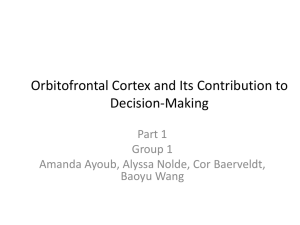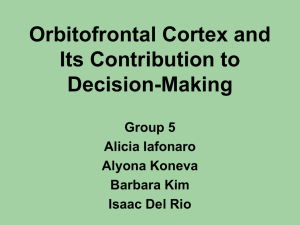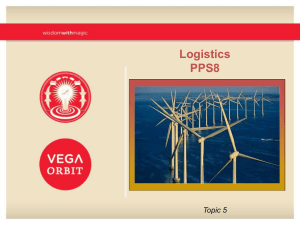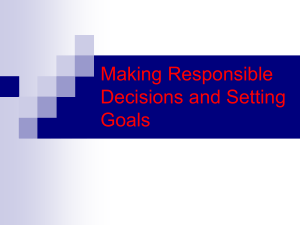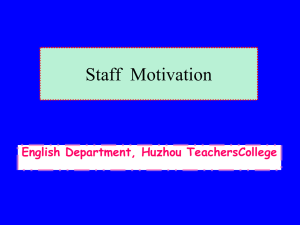Orbital Frontal Cortex Slides
advertisement
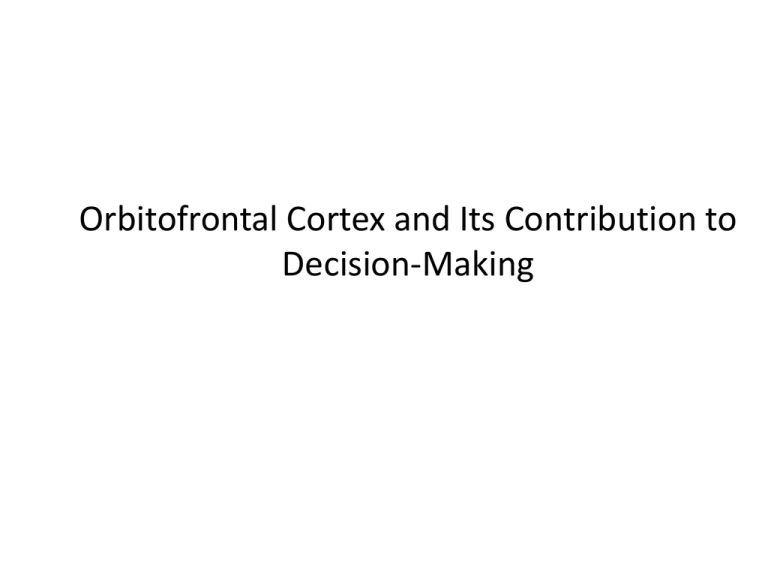
Orbitofrontal Cortex and Its Contribution to Decision-Making •Structural Anatomy of the OFC Part of the PFC and occupies the ventral region of the frontal lobe The OFC integrates sensory and other sources of information to calculate a reward. It contributes to person’s decision making Has 5 architectonic sub-regions 47/12, 10, 11, 13, and 14 The 47/12 region receives highly processed visual and auditory information. The 13 region acts as a bridge between the lateral and medial layers of the brain. Primary olfactory and gustatory cortex project to this region. The 11 region is involved in planning, reasoning, and decision making. Connections in the OFC OFC connections are compatible with a structure that integrates sensory and reward information. Three prominent features: 1. Frontal cortex receives information from all sensory modalities - Area 47/12 processes visual information (from inferior temporal cortex), audio information, somatosensory input (from secondary somatosensory cortex,) and inputs from polysensory areas (like superior temporal cortex) 2. OFC has only weak motor connections, some exist between - 47/12 and supplementary eye fields Area 13 and ventral premotor cortex PFC connects with cingulate motor area Dorsal and later PFC connect with premotor cortex 3. OFC extensively connects with areas of the limbic system - Including the amygdala, cingulate gyrus, and the hippocampus - Influences the autonomic nervous system through the hypothalamus and other brainstem structures Damage to the OFC Story of Elliot Elliot was diagnosed with a brain tumor and had it successfully removed. The surgery left him with bilateral damage to his OFC. Neuropsychologist ran test on Elliot but found no evidence of brain damage. - Tested intelligence, memory, reading and writing comprehension, verbal fluency, visuospatial abilities, and facial recognition; also ran test designed specifically for frontal lobe processes, such as working memory, rule switching, and cognitive estimation did NOT show any deficits Although Elliot did not show any brain damage in the areas listed above, he was affected by the damage in his OFC: Life Before the surgery -Excelled in college -Rose through the ranks of his career -Happily married -Seen as a role model and natural leader Life After the surgery -Devoiced his wife - Quit his job and trouble holding a job -Lost his money to a scam artist -Lost contact with friends and family -Remarried a prostitute and divorced Damage to the OFC leaves our cognitive abilities intact, but demolishes our ability to make decisions in everyday life. Two underlying theories: Stimulus-Reward Learning and Flexible Behavior • Monkey and Man: – Research paradigm: Reverse contingencies • It’s all logical inference: • • Inability to reverse stimulus-reward associations unable to modify his/her behavior in response to negative feedback • OFC is the eraser Underlying theory Somatic Marker Hypothesis • Core idea: • Bodily states (somatic markers) corresponding to the emotions produced while evaluating different courses of action help to facilitate normal decisionmaking. • Somatic markers are associations between reinforcing stimuli that induce an associated physiological affective state. These somatic-marker associations can reoccur during decision-making and bias our cognitive processing (e.g., a burnt child dreads the fire). • Underlying assumption: • James-Lange theory of emotions: Behaviors first, then the emotion • Explanations for Deficits of Decision-making • Iowa gambling task • Stimulus-reward reversals Early theory • Neuronal response to rewards and punishment. Same behavioral and cognitive neuronal sequelae. • Brain areas extracting the value of choice should display reward selectivity before those areas responsible for using the value information to control behavior and cognition. What must we be cautious about… • Neurons that show different firing rates depending on the expected reward outcome are found in different areas of the brain. • A neuron is not necessarily encoding a reward just because its firing rate correlates with some parameters of that reward. Aspect of Reward in OFC encoding • Hedonic value: The degree of happiness or sadness associated with an outcome. • Incentive value: The degree of desirability of an outcome. • OFC: Encoding value of a choice • Reward selective response: Premotor readiness exhibited to carry out reaction to choice. • Time course of encoding neurons across the DLPFC and OFC population • Distribution of peak selectivity across the population of DLPFC and OFC neurons. • The OFC population reaches its peak selectivity about 60ms before the DLPFC population. • Spike histogram from two single neurons encoding the expected reward and/or the monkeys response Localization of Neurons • Reward selective neurons are in both DLPFC and the OFC • The OFC encodes the value of choice outcome and then passes this information to the DLPFC which then uses the information to control behavior. Calculating a rewards value The OFC neurons integrate multiple sensory features of a reward to determine its value. Rewards involve integration and trade-off. Everyday decisions are complex and often requires us to weigh the pros and cons of several variables. Reward value • Monkeys were given a choice between different volumes of different types of liquid, Fruit juice and water. (Wallis) To make its choice the monkey needed to consider both variables: the different Volumes and the different tastes between liquids The monkey may prefer the fruit juice over water, so if the volume was the same, then it would choose the juice. Increasing the volume of the water, would compensate for its taste. The firing rates of OFC neurons were more likely to vary with the value of the drinks, rather than the physical properties (ex: Taste or Volume) A neuron that was encoding the value of the chosen reward might show a higher Firing rate when the monkey choose the one drop of juice to the one drop of water, But the monkey’s firing rate would be the same when choosing one drop of juice to Four drops of water To the monkey, the value of 1 drop of juice is equal to four drops of water. 4 drops of water 1 drop of fruit juice When the value of the two drinks is the same, the neuronal firing rate is also equivalent. Patients with OFC damage • Difficulty integrating the multiple attributes pertaining to a decision. • The OFC is ideal to the multimodal integration of parameters necessary to evaluate an outcome because it receives input from all sensory modalities. • Neuroimaging reveals that human OFC is activated by pleasant and unpleasant smells, sights, sounds and touches, as well as more abstract rewards and punishments like receiving and losing money. Thought… • If a monkey was presented with a choice between food and water, (without considering basic desires of hunger and thirst), would it prefer the food or the water? Is Reward Relative? • Difficult to measure reward in absolute terms • Reward is relative to the specific situation • Value of reward depends on other potential rewards • Lab situation explored ability of subjects to experience regret • Subjects with OFC damage had no regret when making the wrong choice Relative and Non-Relative Information • There is both relative and non-relative information processed in the brain. • We believe most to be relative. • Non-Relative information includes those processes involved in basic needs. Ex: Breathing Need and Reward • Our needs are often complex, encompassing – physiological , – cognitive, – emotional, and – social factors, • but in all cases, these needs affect how valuable a reward is. A reward must satisfy a need. If it does not satisfy a need, it is not valuable. • A need is essential for a reward. Could there be a time when reward has no value? • To be put simply, when there is no need. • In theory, if a person had absolutely everything they could ever need or want, it would be impossible to reward them. However, that is impossible. People can be rich but not be fulfilled spiritually or emotionally and could be rewarded in one of those facets. Con’t • Other times a reward might not be valuable could be: – Coming off of drug addiction and chemical imbalance – Winning the lottery the day after losing a close family member Neutral Events • A “secondary reinforcer” that carries indirect reward only through the its association with a “primary reinforcer” • Needed to the extent that we need primary reinforcers (i.e. moneyfood, water, shelter) • Neutral events act as a means of getting what we really need, but are not needed in of themselves Neuroeconomics • A field that relates models of the parameters that animals/humans use to make everyday decisions to patterns of neuronal firing. • The 3 main parameters that one considers when making a decision: – 1. The expected reward or payoff – 2. The cost in terms of time and energy • Although an outcome may be highly desirable, we may not pursue it if the cost to obtain it is too great. – 3. The probability of success • We need to assess the uncertainty in obtaining the outcome. i.e., risk, or misinterpreting sensory information •Each arm of the T-maze varies the amount of the reward given. •The arm with the most reward has a stipulation: it required more effort to access (barriers the mice had to climb) or it required a waiting period before a gate opens. •Lesions of MPFC: mice chose smaller reward that required less effort •Lesions of OFC: mice chose the smaller reward with more immediate access Neuroeconomics vs. Emotion •. • Considers payoff, cost, and probability of success. This is mostly done by the frontal cortex. •Considers physiological arousal, mood, and motivation. Involves the limbic system and autonomic nervous system •However, emotion plays a large role in neuroeconomics! •Humans rarely make decisions using completely rational methods, such as evaluating cost/benefit ratios. •Much of the time, our decisions are based on our desires and feelings. • Neuroeconomics factors in emotion to help us make clearer predictions about how we decide things.
